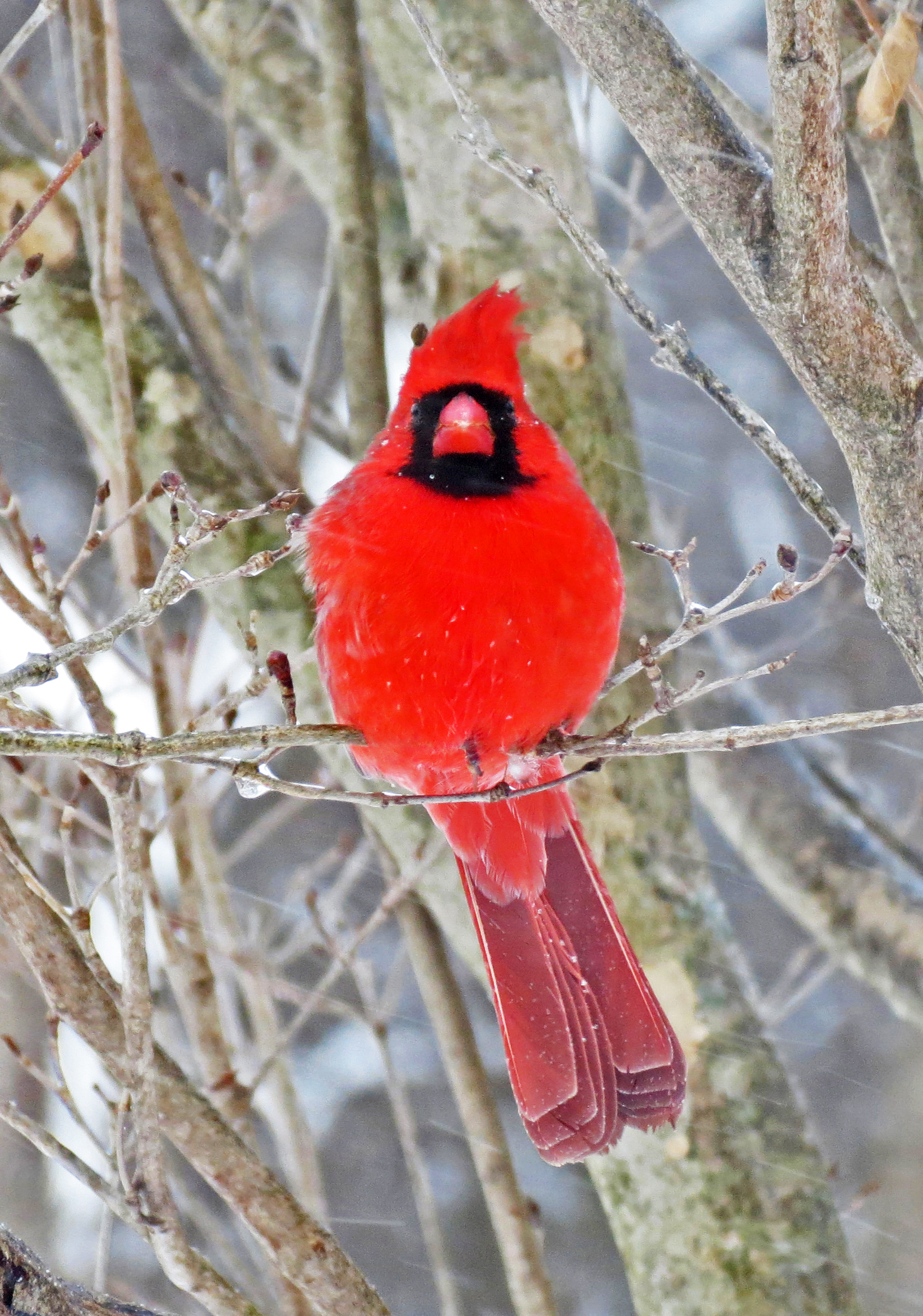All winter, northern cardinals (Cardinalis cardinalis) have been brightening the landscape with their red plumage and their upward-rising whit-whit-whit calls followed by that descending pfew, Pfew call. Three or four pairs of them have been frequenting the bird feeder, lording it over the finches and chickadees. On this cold March morning, one is sitting on the top of the chimney. His song echoes down the flue into the cold fireplace and out into the living room.
Lots of birds have complex and varied songs depending on what they want to say, and the cardinal is a good example. The Audubon Field Guide entry has samples of 10 different songs and calls of the cardinal.
Like all songbirds, cardinals have the ability to sing two songs at once. The only human endeavor I know of that comes anywhere close is the throat singing done by Tibetan monks and some other indigenous peoples. We have a larynx, which we call a voice box. It has a single chamber in which we have two vibrating vocal folds. We make sounds by pushing air over them and making them vibrate. We control the pitch and volume by varying the tension on the vocal cords as well as with air flow and mouth shape, and most of us can only make one sound at a time. This isn’t a problem necessarily, but birds have overcome this limitation.
Where the throat-singers have tricked a generally unused part of their vocal cords into vibrating and producing sound, the cardinal and his avian buddies have it built in for daily use. Instead of a larynx like people have, birds have a syrinx. Where the larynx has a chamber with two vibrating vocal chords, capable of making a single sound, the syrinx in a bird has two chambers and the bird can create two different sounds simultaneously by manipulating the two sides of the syrinx independently. Through a complex of finely-tuned muscles controlling each side of the syrinx along with air movement, opening and closing the beak, song birds like the cardinal can produce these highly complex sounds. Variations in the syrinx provide “voice” variations between and within species, giving each bird a voice as unique as ours are. The upshot of this arrangement is that birds can and do make complex sounds that I cannot mimic no matter how hard I try. The bird can also trade off sides of the syrinx seamlessly. One example for the cardinal is its continuous, upward whistle. It uses one side of the syrinx to produce the first half of the sound, and the other side to pick it up to complete it in the higher register.
Cardinals are native to North America. They’ve stayed all winter, fluffing themselves up to stay warm, feeding on seeds and whatever insects they can find. They’re slightly smaller than an American robin, with a head to tail length of about eight and a half to nine inches. They weigh in around 1.5 ounces with a wing span of 9 to 12 inches. Named for the red-robed cardinals in the Catholic church, the males wear their bright red feathers all year round, with black around their reddish bill. Females aren’t so bright-colored. Instead, they are pale brown with reddish highlights on their wings, tails and crests. They have the same long tails and short, thick orangish-reddish bill surrounded by black on their face as their male counterparts.
Cardinals like to live in brushy, tangled bushes at the edges of woods and forests. That’s probably why we have them here on Owl Acres. We have undisciplined fence rows and clumps of trees with tangles of vines and bushes in the middle. Not particularly beautiful to the lawn and garden types, but attractive as good habitat for the beautiful birds. The female will make an open-cup-shaped nest here, and raise up to three broods this summer while her male partner defends the territory and helps her feed the nestlings. She might hook up with last year’s mate, or she might find a new partner for this year.
Although they don’t migrate, the cardinals still promise spring even before the robins. In February or so, those bright red splashes of color are busy singing and courting, trying to convince the ladies to join them in raising a family. Their song announces that the robins and the spring are on their way. And we all think it’s about time!
Photo by James St. John

1 comment